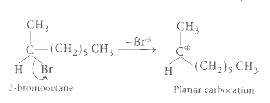Assertion (A )SN 1 hydrolysis of optically active -2 bromooctane results in the formation of (±) - octan -2-ol .
Reason (R ) The reation proceeds through a planar carbocation which can be attacked by the nucleophile from either side.
The correct answer is Solution in Telugu
(A) and (R ) are correct (R ) is the correct explanation of (A )
(A ) and (R ) are correct (R ) is not the correct explanation of (A)
(A) is correct but (R ) is not correct
(A) is not correct but (R ) is correct
The correct Answer is:A
Given Assertion (A) and the Reason (R ) both are correct and the given Reason (R ) is the correct explanation of the given (A ).
Because SN1 reactions occurs through the formation of carbocation and in Sn1 reaction both front as well rear attack of nucleophile at carbocation are possible . In 2- bromooctane following carbocation is formed.

Thus option (a )is the correct anser.
Topper's Solved these Questions
- AP EAMCET ( ONLINE QUESTION PAPER 2018 SOLVED)BOOK - TS EAMCET PREVIOUS YEAR PAPERSCHAPTER - AP EAMCET ( ONLINE QUESTION PAPER 2018 SOLVED)EXERCISE - CHEMISTRY
40 Videos
- AP EAMCET ENGINEERING ENTRANCE EXAM ONLINE QUESTION PAPER 2019 (SOLVED)BOOK - TS EAMCET PREVIOUS YEAR PAPERSCHAPTER - AP EAMCET ENGINEERING ENTRANCE EXAM ONLINE QUESTION PAPER 2019 (SOLVED)EXERCISE - Chemistry
40 Videos
Similar Questions
The work functions (W0) of K, Na, Li, Mg and Cu are 2.25 , 2.30 ,2.42 ,3.70 and 4.80 eV respectively. How many of these metals do not undergo photoelectric effect when a radiation of wavelength 450 nm is allowed to fall on them ? (1eV = 1.602×10−19J)
View SolutionWhich of the following equations does represent the velcity (v) of the ejected electrons when a metal is made to strike with light of frequency v and threshold frequency of the metal is v0 ?
( me = mass of electron and h is Plank's constant)
View SolutionAssertion:- SN2 reaction proceeds with inversion of configuration.
Reason:- The attack of nucleophile occurs from a side opposite to the halogen atom resulting in inversion of configuration.
View SolutionAssertion (A) Hydrolysis of (-)-2-bromooctane proceeds with inversion of configuration
Reason (R) This reaction proceeds through the formation of a carbocation.
View SolutionAssertion: Hydrolysis of (-)-2- bromooctane proceeds with inversion of configuration. Reason: This reaction prioceeds through the formation of a carbocation.
View SolutionAssertion: Hydrolysis of (-)-2- bromooctane proceeds with inversion of configuration.
Reason: This reaction prioceeds through the formation of a carbocation.
View SolutionAssertion (A) : Hydrolysis of (-)-2-bromooctane proceeds with inversion of configuration.
Reason (R) : This reaction proceeds through the formation of a carbocation.
View SolutionS_(N)1 // S_(N)2 proceeds through the formation of a carbocation.
View SolutionAlkylhalides have polar C-X bond and undergo nucleophilic substitution reactions. These give a variety of products with nucleophiles such as -OH, -OR, -NH_(2), -CN, -NC, -NO_(2), -ONO, RCOO^(-) , etc. They undergo mainly two types of nucleophilic substitution reactions, S_(N)1 and S_(N)2 . S_(N)1 reactions are two steps reactions which proceed through the formation of carbocations while S_(N)2 reactions are one step reaction which proceeds through the formation of transition state. The stability of carbocation and transition state determine the reactivity of alkyl halides. Which out of S_(N)1 or S_(N)2 results into inversion of configuration?
View SolutionAssertion: tert-butylbromide undergoes S_(N)1 nucleophilic substitution readily than n-butyl bromide. Reason: It proceeds by the formation of stable carbocation.
View SolutionS_(N)1 // S_(N)2 proceeds through the formation of a carbocation.
View SolutionAlkylhalides have polar C-X bond and undergo nucleophilic substitution reactions. These give a variety of products with nucleophiles such as -OH, -OR, -NH_(2), -CN, -NC, -NO_(2), -ONO, RCOO^(-) , etc. They undergo mainly two types of nucleophilic substitution reactions, S_(N)1 and S_(N)2 . S_(N)1 reactions are two steps reactions which proceed through the formation of carbocations while S_(N)2 reactions are one step reaction which proceeds through the formation of transition state. The stability of carbocation and transition state determine the reactivity of alkyl halides. Which out of S_(N)1 or S_(N)2 results into inversion of configuration?
View SolutionAssertion: tert-butylbromide undergoes SN1 nucleophilic substitution readily than n-butyl bromide.
Reason: It proceeds by the formation of stable carbocation.
View SolutionAssertion (A): In the case of optically active alkyl halide, the product formed as a result of SN2 mechanism has the inverted configuration as compared to the reactant.
Reason (R) In SN2 mechanism, the nucleophile attaches itself on the side opposite to the one where the halogen is present resulting in inversion in configuration of the product.
View SolutionAssertion (A) : Hydrolysis of (-)-2 -bromooctane proceeds with inversion of configuration. Reason (R ) : This reaction proceeds through the formation of a carbocation.
View Solution
